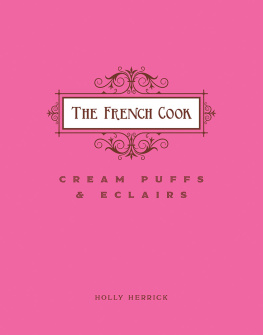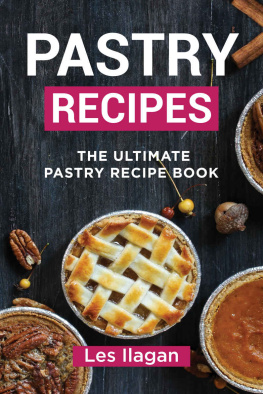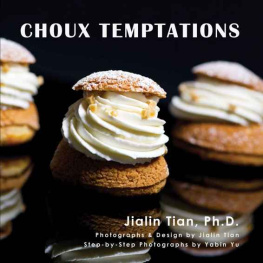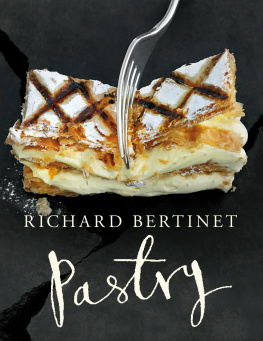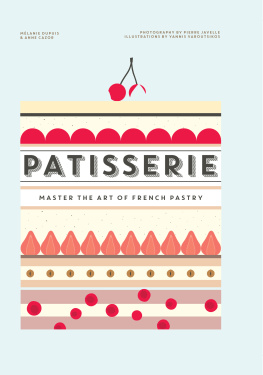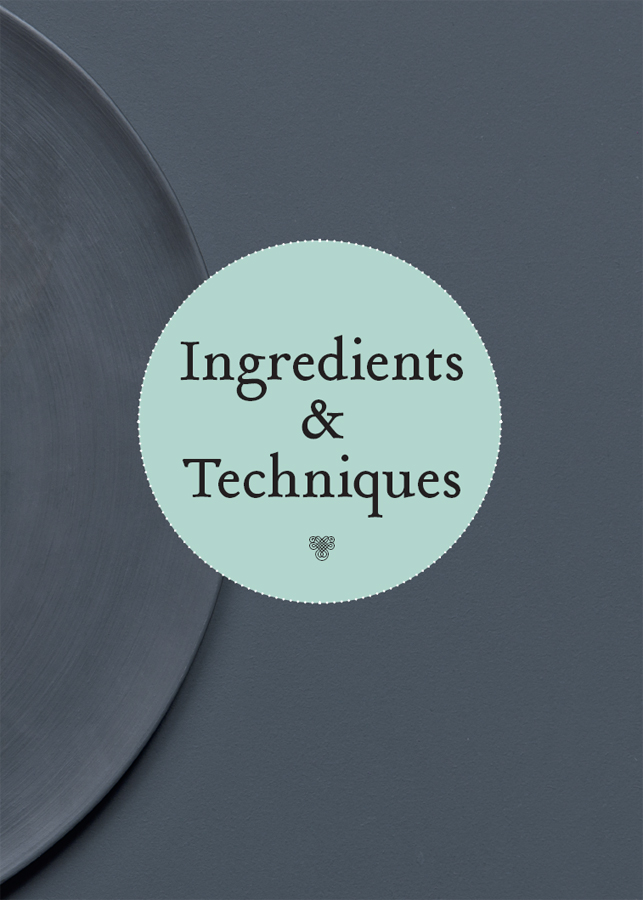For Jrme and Antoine
To my sister, my mother and my father
PREFACE
Choux is a pastry thats unlike all others.
In the first place, it is one of the only pastries that is prepared over heat or, in French, chaud, which is very likely the origin of its name: pte chaud (hot pastry). Its originality also lies in the fact that it calls on the talents of the pastry cook (in particular, precision) as much as those of the regular cook (whose intuition plays a major role in making the recipes). Thus, while in any pastry recipe you need to make sure you have the correct quantities of ingredients, it is impossible in the case of choux pastry to know in advance exactly how many eggs you will need. Everything depends on how long the ingredients are boiled in the saucepan and then how much the choux mixture is dried out, and these things are impossible to measure, either in time or in weight. It is above all a matter of observation. Observing the consistency of the mixture before using it: neither too dry, nor too wet, it must stick to the spatula for around ten seconds before dropping off. Its something that can be easily adjusted right at the end of the recipe, as long as you dont get carried away. Everything is explained in detail in this book!
Once the choux dough is ready, you can have fun with the piping bag. Tubes of dough will be transformed into clairs and then secretly filled with sweet crme ptissire, or sliced open to hold rosettes of light and pretty chantilly cream. Glossy icing completes the visual delight.
Once your mixture has the right consistency, the whole realm of choux pastry is yours: they wont ever flop again. They will be beautiful, puffed up and golden, ready to be customised in every way and devoured without delay!
TABLE OF CONTENTS
EGG
THE EGG GIVES THE CHOUX BUN ITS SHAPE, IN EVERY SENSE ... WHEN IT IS INCORPORATED INTO THE CHOUX MIXTURE, IT BRINGS WITH IT THE AIR THAT WILL GIVE THE PASTRY ITS ROUNDED SHAPE. IT ALSO GUARANTEES A BEAUTIFUL GOLDEN CRUST.
COMPOSITION
Generally speaking, the yolk represents 30 per cent of the weight of the whole egg (or 16 g/ oz for a large egg), the white, 60 per cent (or about 32 g/ 1 oz), and the shell, 10 per cent.
The white, which is 90 per cent water and 10 per cent protein, is made up of two substances with different viscosities: a thick white that congregates around the yolk and a more liquid white located around the periphery. The fresher the egg, the more thick white it contains.
The egg yolk is made up of 50 per cent water, 15 per cent protein and 35 per cent fat. It also contains some carbohydrate and significant amounts of vitamins A,B , D, E and K. In the recipes in this book, large eggs are used (5363 g/2-2 oz).
PEAKED EGG WHITES: EGG WHITES AND SUGAR
To successfully whisk egg whites into peaks, you need to whisk them on medium speed, add a little caster (superfine) sugar (poured in gradually in a light stream) when the peaks start to form and, finally, whisk on maximum speed. Stop as soon as you can turn the bowl upside down without the whites falling out.
WHAT TO WATCH FOR
Overbeaten egg whites (especially when no sugar has been added): they become grainy, which is to say they take on a curdled appearance. Adding sugar helps the air bubbles divide: they become smaller and more numerous. The egg whites are thus firmer and more stable.
Adding too much sugar at the beginning: the water in the egg whites will become viscous and they wont froth up as easily. The way the sugar is incorporated is important: too late and you run the risk of grainy whites; all at once and the whites will collapse.
The wrong type of sugar: icing (confectioners) sugar sometimes makes the egg whites too viscous; standard white (granular) sugar doesnt dissolve well. Only caster (superfine) sugar should be used.
EGG YOLKS AND SUGAR
When you combine egg yolks with sugar, it is essential that you whisk the mixture immediately, otherwise the sugar crystals absorb water and dehydrate the yolk, which then becomes grainy.
WHEAT FLOUR
YOU CANT MAKE CHOUX PASTRY WITHOUT THE INIMITABLE QUALITIES OF GLUTEN, UNIQUELY ABUNDANT IN WHEAT FLOUR.
STARCH
Starch is found in, among other foods, rice, dry legumes, wheat, potato and cassava, which are staple foods in most countries.
Heated in a liquid, starch increases the liquids viscosity until it reaches a peak. If the individual grains that make up the starch arent cooked enough, they dont swell up enough to thicken the preparation, which will remain too liquid and leave a floury taste in the mouth. If cooking is continued after peak viscosity is reached, this viscosity diminishes. This is what you are looking for when you make a crme ptissire: you allow it to boil until it relaxes. Finally, when you leave the mixture to cool, it thickens considerably. This allows you to make the crme ptissire, for example, without adding gelatine and extra fat.
GLUTEN
Gluten gives pastry its elasticity, hold, cohesion and gas-retention properties. It ensures the pastry holds together and allows it to rise. This is what we need for choux pastry, which, like bread, needs to rise without baking powder.
WATER
The usual moisture level of flour is about 14 per cent. Excess moisture affects the flours storage qualities (it may attract mould).
MINERALS
The minerals in flour are located in the outer layer of the wheat grain, the bran. The more bran retained, the higher the mineral content of the flour. Plain (all-purpose) flour, for example, contains fewer minerals than strong or bread flour.
FLOUR AND CHOUX PASTRY
For choux pastry, it is recommended you use plain (all-purpose) flour, sifted.
BUTTER
BUTTER GIVES CHOUX PASTRY ITS FLAVOUR,
COLOUR AND SUPPLE TEXTURE.
CHARACTERISTICS
From a nutritional point of view, fat acts as a high-energy fuel, forms the membranes of our cells and carries the liposoluble (dissolvable in fat) vitamins we need (A, D, E and K). Butter is also an asset on a sensual level: it harnesses flavours, adds softness in the mouth and produces an agreeable sensation of warmth on the palate. Fats can also lead to cardiovascular problems, which is why nutritionists recommend a daily intake of no more than 1 g fat per kilo of body weight.


